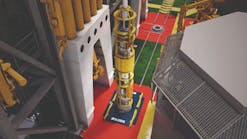Jessica Tippee • Houston
CNOOC commissions Aker for power umbilical systems
Aker Solutions will supply power umbilical systems to CNOOC’s Liuhua oil fields in the South China Sea.
The NOK350 million-plus ($41.5-million) work scope includes more than 35 km (21.7 mi) of dynamic and static power umbilicals for the Liuhua 16-2, 20-2, and 21-2 fields, linking the subsea development to a new FPSO.
Aker Solutions will employ its OsciLay process for the static section of the Liuhua 16-2 umbilical.
Power umbilical systems are bundled cable and fiber optic systems providing distribution of power, control, and communication between subsea equipment on the seabed and platforms or floating production facilities. (Courtesy Aker Solutions)
According to Greg Ross, the company’s vice president subsea sales in Asia Pacific, the process “addresses challenges of more extreme tension loads during installation, eliminating splicing of cables due to manufacturing weight limitations…
“OsciLay allows us to manufacture extremely long or heavy power umbilicals which will otherwise be limited using conventional manufacturing approaches.”
The company’s team in Malaysia will lead the engineering program, with umbilical production performed in Mobile, Alabama. The consignments for Liuhua 16-2 and 20-2 should be delivered by the end of 2019 and the Liuhua 21-2 package in 2020.
Wood outlines next-phase priorities for subsea network
Wood has extended the SURF IM Network, which the company formed in 2014 with a view to sharing experience and lessons learned from subsea integrity and reliability issues. The initiative is at present supported by BP, Chevron, ExxonMobil, Hess, Husky, Petronas, Shell, Suncor, Total, and Woodside.
SURF IM facilitates face-to-face forums, the focus areas including subsea hardware, component failures, operations experience, and emerging inspection and condition monitoring technologies.
Collectively seeking to gain a better understanding of how to mitigate subsea production system failures will potentially bring operators significant cost savings while ensuring safer operations, Wood added.
The network is said to benefit both members and the supply chain, encouraging innovative solutions to address challenges.
Bob MacDonald, CEO of Wood’s Specialist Technical Solutions business, said: “In previous phases of the network, we have successfully worked to address key issues affecting the sector, including subsea control module reliability, choke valve reliability and cost efficiencies in a low oil price environment.
“The next phase will focus on a range of subsea integrity and reliability challenges, including life extension risk, degradation of electrical distribution systems, interventions and remediation strategies.”
The previous SURF IM joint industry project identified key failure mechanisms, investigated inspection and monitoring technologies, and developed best practice guidelines for subsea facilities.
Saipem wins wide-ranging SURF contract for Liza Phase 2
ExxonMobil has awarded Saipem more contracts for the deepwater Liza field development in the Stabroek block offshore Guyana. These are in addition to those assigned to the company last year by affiliate Esso Exploration and Production Guyana Ltd. for the first-phase Liza program.
Saipem will now perform detailed engineering, procurement, construction, and installation of the risers, flowlines, and associated structures and jumpers for Phase 2, and will also transport and install umbilicals, manifolds, and associated foundations for the production, and water and gas injection systems.
Liza is 200 km (124 mi) offshore in water depths of up to 1,850 m (6,069 ft). The second phase of the development has a larger number of wells and associated subsea equipment than Phase 1, and will produce around 220,000 b/d.
Stefano Cao, Saipem’s CEO, said the company would likely deploy the recently acquired vessel Constellation, alongside its FDS2, for the offshore installations.
SEA, Wood supporting Scarborough concept studies
Woodside Energy has contracted Wood to support concept definition for the proposed Scarborough development offshore Western Australia. The contractor’s field development studies team in Houston and Perth will work on concept definition level engineering associated with the floating production unit, subsea umbilicals, risers and flowlines, flow assurance and overall system integration of the upstream development.
In addition, the operator has awarded Subsea Engineering Associates Pty Ltd. (SEA) the contract for define phase engineering services for the development’s export trunkline. This will enable SEA to use the ICE Platform and enable rapid delivery of engineering and a mature digital basis of design to be carried into front-end engineering and design. SEA has subcontracted INTECSEA Pty Ltd. to provide specialized deepwater expertise.
The Scarborough field is 375 km (233 mi) west-northwest of the Burrup Peninsula. The proposed development includes a 430-km (267-mi) large diameter export trunkline routed from a deepwater infield facility, up and over the continental shelf and onto the Woodside-operated infrastructure on the Burrup Peninsula. •
The proposed upstream development concept is to fully develop the Scarborough gas field with up to 12 subsea, high-rate gas wells tied back to a semisubmersible floating production unit. (Courtesy Subsea Engineering Associates)








